今日推荐开源项目:《12306 购票小助手》
今日推荐英文原文:《The Release Ratio: How to Make Use of Everything You Know》
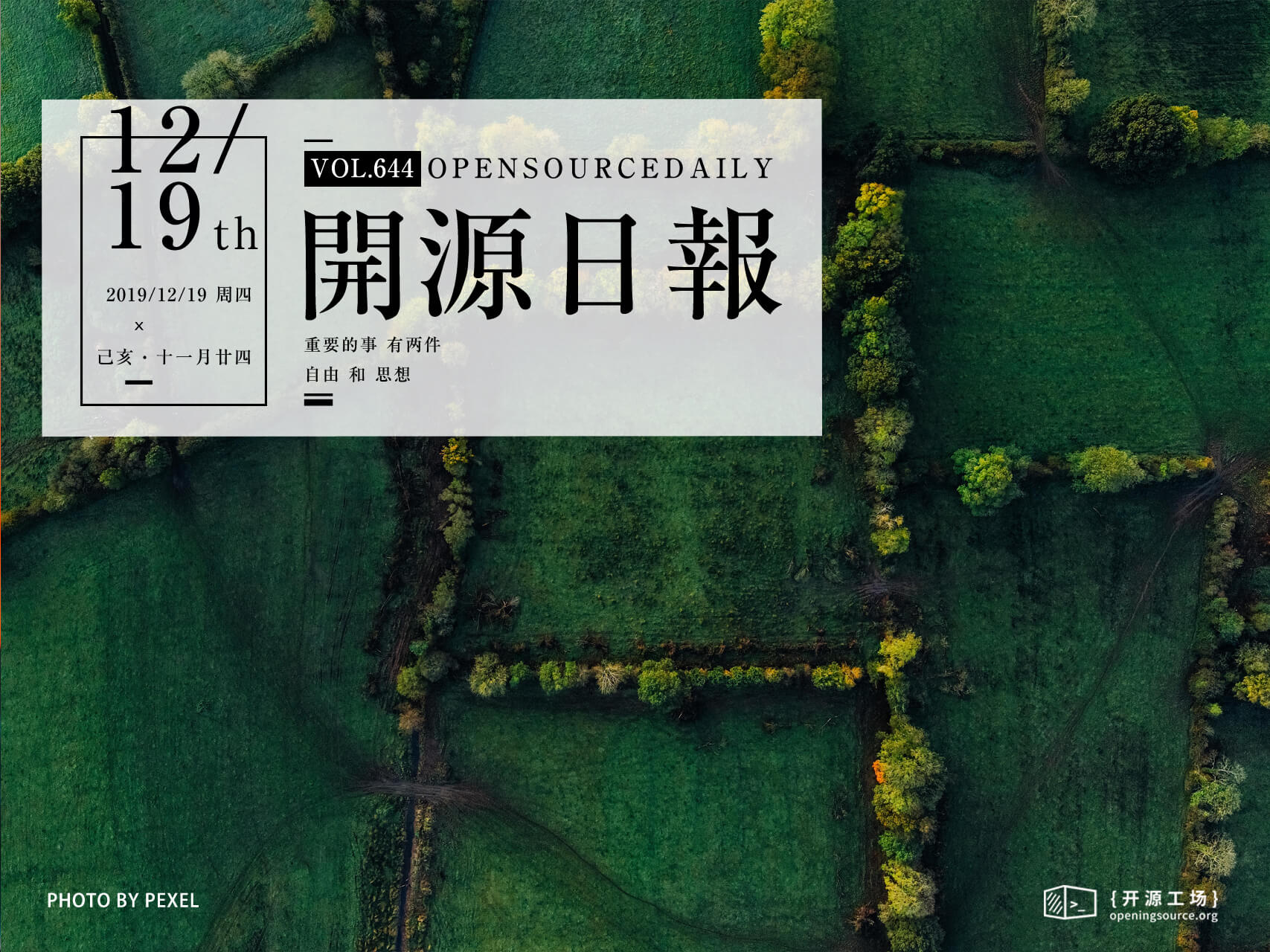
今日推荐开源项目:《12306 购票小助手》传送门:GitHub链接
推荐理由:顾名思义,很简单,能在春运来临之时助你一臂之力。不用多想,它只是用技术手段省去了你用手指操作的繁琐的过程而已(不过是在此之前增加了一些繁琐的配置过程罢了,不过嘛,这应该是值得的)。人生苦短,我用Python。
今日推荐英文原文:《The Release Ratio: How to Make Use of Everything You Know》作者:More To That
原文链接:https://humanparts.medium.com/the-release-ratio-how-to-make-use-of-everything-you-know-7ef9f3e9c691
推荐理由:当获取知识成为最终目的时,知识就失去了它的意义。还是那个问题:知识的输入与输出。
The Release Ratio: How to Make Use of Everything You Know
One simple metric converts knowledge into something special
Meet Mr. Podcast.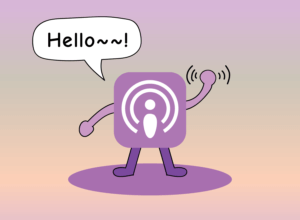 Mr. Podcast is great. He delivers information instantly, and you can do many other things while listening to him.
Mr. Podcast is great. He delivers information instantly, and you can do many other things while listening to him.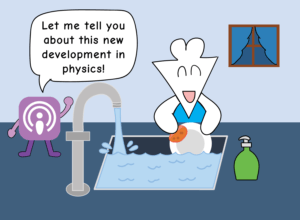 Here’s Mrs. Video.
Here’s Mrs. Video.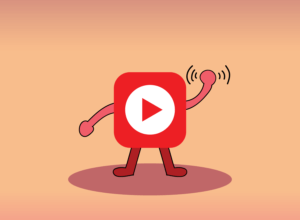 She’s an amazing educational resource, and has the ability to condense difficult concepts into digestible pieces. She makes learning fun, and makes you feel like a kid again when you hang out.
She’s an amazing educational resource, and has the ability to condense difficult concepts into digestible pieces. She makes learning fun, and makes you feel like a kid again when you hang out.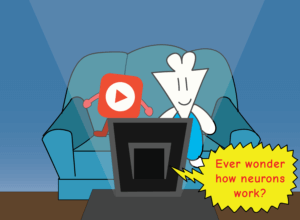 Finally, meet Mr. Book.
Finally, meet Mr. Book.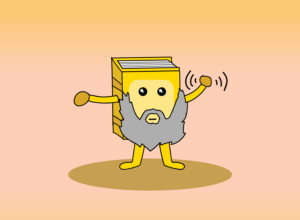 He’s the sage of the group, and has been around for quite some time. So when you’re with him, he’d like a little respect.
He’s the sage of the group, and has been around for quite some time. So when you’re with him, he’d like a little respect.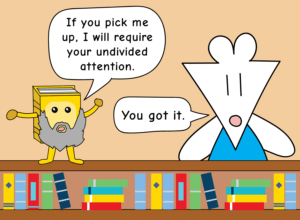 You love Mr. Podcast, Mrs. Video, and Mr. Book.
You love Mr. Podcast, Mrs. Video, and Mr. Book.They’re always telling you about cool shit, and you love how they motivate you to live your best life.
Every day they give you brain fuel. With every word you hear, every visual you watch, and every sentence you read, your mind container fills up as you learn more about the world.
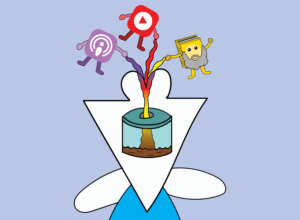 This feels great, but at some point, your mind starts getting a little… full.
This feels great, but at some point, your mind starts getting a little… full.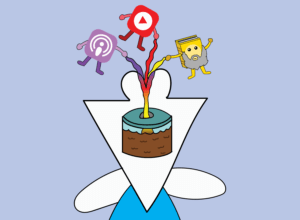 You feel it loading up, but you tell yourself that you must keep going. You can never have enough knowledge, and it’s so easy to acquire anyway.
You feel it loading up, but you tell yourself that you must keep going. You can never have enough knowledge, and it’s so easy to acquire anyway.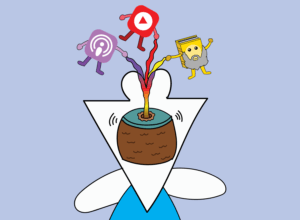 This brain fuel keeps pouring in…
This brain fuel keeps pouring in…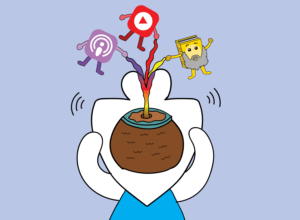 Until one day, you feel fucking nauseous.
Until one day, you feel fucking nauseous.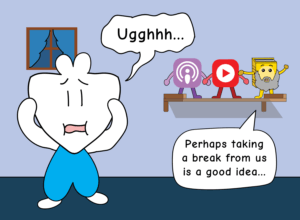 The mind is just like the stomach. Give it too much stuff without the proper release, and you’ll get sick.
The mind is just like the stomach. Give it too much stuff without the proper release, and you’ll get sick.When you consume content, it’s good up to a certain point. It’s great to learn more about the world, but then you must follow that up with: “Okay, so what do I do with all this information?”
If you never act on that question, then content consumption turns into an unhealthy feedback loop. You start tricking yourself into believing that knowledge acquisition is the end goal. This is when Mr. Podcast, Mrs. Video, and Mr. Book are no longer useful, regardless of how rich in quality they are.
They quickly become empty calories: pseudo-foods that make you feel like you’ve accomplished something simply by consuming them.
To convert this fuel into something productive, there’s really only one thing we can do.
Introducing the Release Ratio
Last month, I had a great conversation with a close friend of mine. He told me that he’d been reading a lot of great stuff lately, but felt a sneaking sense of discomfort afterward. He was soaking up so much knowledge, but felt like he wasn’t making the proper use of it.
He framed his conundrum with this question: “How can I increase the ratio of content I create over the content I consume?”
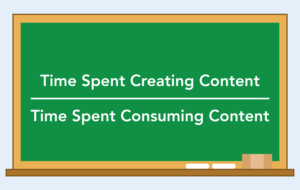 This ratio he spoke of was an elegant way of framing the problem at hand, while also delivering a solution.
This ratio he spoke of was an elegant way of framing the problem at hand, while also delivering a solution.To make content consumption meaningful, you must create or build something with it. It can be something concrete like a product or a service. It can even be something more process-driven like a habit or culture.
Regardless of what you build, it is this very act of creation that releases the brain fuel inside your head. All the knowledge you have is a store of wisdom, but you will never unlock that wisdom if you never act upon what you know.
The ratio my friend spoke of — which I will call the “Release Ratio” — is a good way of managing the level of brain fuel you have.
Every mind container comes with a built-in release valve. When opened, it will expel some of the contents of the mind out into the world.
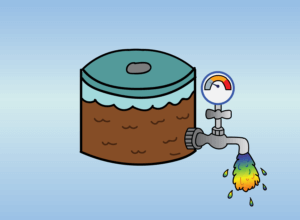 The rate of release is determined by our ratio. The higher it is, the more fuel is processed and poured out. The lower it is, the less fuel is utilized, and the more knowledge remains in your head.
The rate of release is determined by our ratio. The higher it is, the more fuel is processed and poured out. The lower it is, the less fuel is utilized, and the more knowledge remains in your head.Unsurprisingly, the default setting of the valve has its Release Ratio set to zero. It’s much easier to consume countless of hours of podcasts, videos, and books than to spend time creating anything with what you’ve learned. We tend to allow inaction unless we have to choose otherwise.
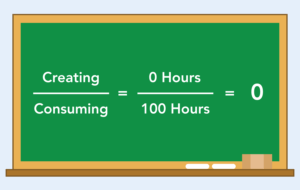 But as we described earlier, a tightly shut valve leads to a restless mind. Having all this information without the proper release is discomforting.
But as we described earlier, a tightly shut valve leads to a restless mind. Having all this information without the proper release is discomforting.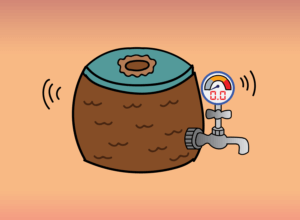 So the first step is simple: keep the Release Ratio above zero, no matter how small that number is.
So the first step is simple: keep the Release Ratio above zero, no matter how small that number is.Release a tiny bit of brain fuel by starting small
When starting out, just keep this image in mind:
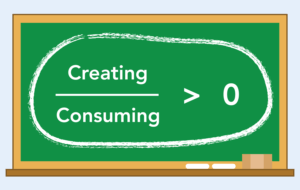 It doesn’t matter if the Release Ratio is 0.1 or 0.001. Start small. Make something that just takes five to 10 minutes of your day — possibly even less. All that matters is that the valve is cracked open.
It doesn’t matter if the Release Ratio is 0.1 or 0.001. Start small. Make something that just takes five to 10 minutes of your day — possibly even less. All that matters is that the valve is cracked open.One way to do this is by starting a daily journal. Writing down your thoughts and learnings is, in fact, an act of creation. The combination of words you put down are imbued with a unique fingerprint that no one else can replicate.
Even if you listen to three hours of podcasts each day, journaling for 10 minutes allows you to synthesize some of that information and reframe it with your own perspective. Through this simple act of writing, you have created something new, and that’s all that matters.
“Creating something” can sound daunting, but really, anyone can do it.
Record a short voice note after you read something. Jot down some business ideas you’ve had recently. Draw a quick sketch of a character you made up, or of one that already exists. These small acts of creation make use of your brain fuel by opening the valve, giving the container a little more room to breathe.
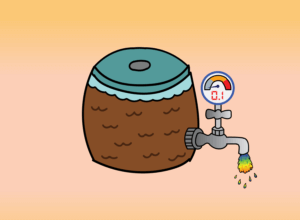 Like most things worthwhile, the hardest part is the start. But remember, all you need to do is to keep the Release Ratio above zero. That’s the golden rule. Once you’re able to do that consistently, then you’re ready for the next step.
Like most things worthwhile, the hardest part is the start. But remember, all you need to do is to keep the Release Ratio above zero. That’s the golden rule. Once you’re able to do that consistently, then you’re ready for the next step.Commit to projects for a higher release ratio
If you really want to make good use of your brain fuel, it’s time to up the commitment. Setting aside 10 minutes of your day was a good way to warm up, but real exercise comes with longer-term, dedicated projects.
This is when short voice notes become structured, hour-long podcasts. It’s when quick journal entries evolve into long-form blog posts. It’s when your business plan actually becomes a business.
This is when you really start making use of all the knowledge you have. Your brain fuel is now allocated to a dedicated project, and is used up frequently in regular intervals.
In other words, your knowledge now has purpose.
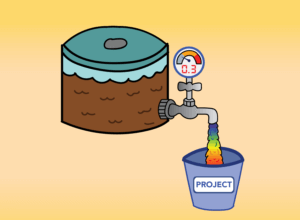 This is an awesome thing, and I can validate this through personal experience.
This is an awesome thing, and I can validate this through personal experience.Before I started More To That, all the content I consumed would just sit in my mind. The only release I’d have is if I regurgitated some quote I heard to my wife or friends, or if I slightly adjusted my behavior based on something a prominent scientist said.
But now that I have this blog, all the ideas I come across are just oozing with creative potential.
All the cool shit I read, watch, discuss, or listen to can become the foundation for a new post. Anything I find interesting is fair game, and I can combine all these ideas together to create something compelling for the blog.
Having a dedicated project allows you to see the world through that project’s lens. It increases your awareness of informational inputs, as they now have a purpose to fulfill. This leads to higher creative output, which ups the rate of release set by the Release Ratio as well.
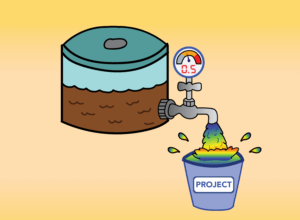 At this stage, you’re spending hours each day creating things, not minutes. Your mind container is being emptied out at a rate that allows for more brain fuel to come in, and this all feels healthy and productive.
At this stage, you’re spending hours each day creating things, not minutes. Your mind container is being emptied out at a rate that allows for more brain fuel to come in, and this all feels healthy and productive.However, with a Release Ratio of less than 1.0, that means that you will always be consuming more content than creating. For example, a ratio of 0.5 means that you will be creating one hours’ worth of stuff for every two hours’ worth of material being poured into your mind.
But what if the numerator is increased significantly? What if you’re creating things for 5 hours a day? Does that mean you have to consume 10 hours’ worth of brain fuel?
Of course not. This likely means that you won’t have much time to read books, watch videos, or listen to podcasts. If you’re creating things for 5 hours each day, maybe you’ll only have an hour at the end of the night to read.
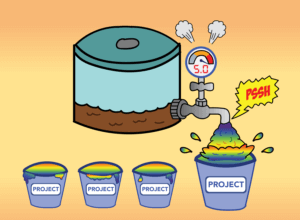 This is a scenario in which the Release Ratio is greater than 1.0, or when you create more than you consume. This is common amongst full-time content creators: writers, artists, designers, entrepreneurs, etc. In fact, it’s probably the default setting for this group of folks.
This is a scenario in which the Release Ratio is greater than 1.0, or when you create more than you consume. This is common amongst full-time content creators: writers, artists, designers, entrepreneurs, etc. In fact, it’s probably the default setting for this group of folks.Whether it’s driven by fleeting inspiration or habitual routine, a creator can work on something for many hours each day at sustained intervals. This certainly feels productive, but remember that creation and consumption are inextricably linked. Our ability to create things is contingent upon the inputs that we receive from the world.
A writer writes because he reads. A filmmaker creates because she watches. An entrepreneur builds because she observes.
Focused creation is good… up to a point. If you keep creating stuff without taking time to refill the mind, this inevitably leads to one thing:
Burnout.
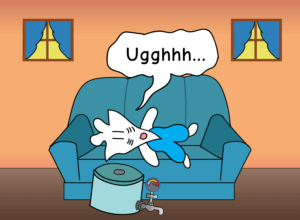 When the mind container is empty, there is nothing to draw upon. You can try to create stuff without brain fuel, but the quality of what you make will suffer.
When the mind container is empty, there is nothing to draw upon. You can try to create stuff without brain fuel, but the quality of what you make will suffer.This is why companies pause and take retreats. It’s why artists go into the wilderness to recalibrate. It’s why Bill Gates secludes himself in a remote cabin for a week to read and think.
You can have periods of time where your Release Ratio is greater than 1.0 — sometimes even pushing into the 10.0’s — but one day, you will run out of fuel. You can either keep pushing hard and burn yourself out, or take a few days to populate your mind with good reads and interesting conversations.
Life is a long-term game, so I advise that you choose the latter.
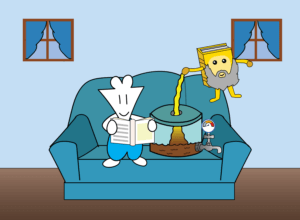 Like all things worthwhile, there’s an intricate balance to consider. Being a knowledge sponge is fun, but you need the proper release to make it meaningful. Release too much without refilling, however, and you’ll be a wiry ball of fatigue.v
Like all things worthwhile, there’s an intricate balance to consider. Being a knowledge sponge is fun, but you need the proper release to make it meaningful. Release too much without refilling, however, and you’ll be a wiry ball of fatigue.v
Despite the ebbs and flows, there’s one rule that stands: keep your Release Ratio above zero. Start small if you have to. The aim is to crack the valve open just a bit so your mind has some room to breathe.
We love living in a world where Mr. Podcast, Mrs. Video, and Mr. Book are our friends, but that friendship is usually a one-way street. We soak up all the knowledge they hold, but don’t give anything back in return.
The best way to close this loop is to create something yourself.
Take the brain fuel you’ve been given and make something with it. What you make, in turn, will become fuel for the next person. After all, this is the nature of creativity: The creations of one become the inspiration for another, and the cycle continues.
 If you enjoyed this post, consider joining the More To That email list.
If you enjoyed this post, consider joining the More To That email list.下载开源日报APP:https://openingsource.org/2579/
加入我们:https://openingsource.org/about/join/
关注我们:https://openingsource.org/about/love/
